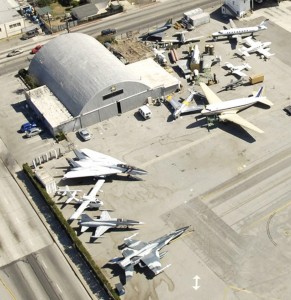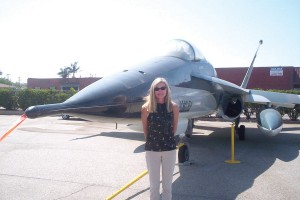By Fred “Crash” Blechman

The Western Museum of Flight, located at the extreme northwest corner of Jack Northrop Field, Hawthorne Municipal Airport, has many unusual aircraft in the hangar and on the outside ramp.
The Western Museum of Flight, located less than five miles from Los Angeles International Airport since 1981, is now threatened with closure. Its large hangar and ramp are at the extreme west end of the runway at Jack Northrop Field, Hawthorne Municipal Airport. This is prime “grandfathered” property, where new construction is no longer allowed so close to the runway.
Jack Northrop Field derives its name from the fact that this was the place where for many years the Northrop Aircraft Corporation designed, built and flew many classic airplanes, including various flying wings, the P-61 Black Widow and the F-89 Scorpion night fighters, the F-5 Freedom Fighter, and the T-38 Talon jet trainer. The museum may be the victim of an attempt by new developers to convert the prime location of the museum hangar to a business jet facility, since the almost-5,000-foot runway is long enough for many business jets. With the expiration of the current lease on April 1, 2006, and a recent large increase in the monthly rent, the museum is faced with either moving or closure.
Background
The Western Museum of Flight and its restoration facility are operating elements of the nonprofit Southern California Historical Aviation Foundation, which was founded in 1979.
“In the early 1980s, the museum was originally Northrop-company inspired,” said Cindy Macha-Skjonsby, museum director and president of SCHAF. It began with the restoration of the N-3PB patrol bomber, which was done on site at Northrop. That was started in the late 1970s, but they didn’t have a building until 1981.
“Before there was an operating arm, called the Western Museum of Flight, the foundation was comprised mainly of Northrop management,” she said. “Northrop footed the bill originally. Many of the planes here are former Northrop aircraft. We even have an F-89 Scorpion here that needs to be restored when we know we have a permanent home.”
The museum has been in operation for 25 years. It’s supported by donations from people who attend, and events such as the recent third annual Air Faire as well as some smaller events throughout the year. Also, the Northrop Grumman Federal Credit Union provides a monthly donation.
The problem
Recently, the City of Hawthorne arranged a 45-year lease to a triad, a group of three developers who want to transition this airport from general aviation to a business jet center. The museum rent was increased from $2,000 to $5,000 a month, with a lease end-date of April 1, 2006.
“The city turned the airport over to a developer because they were having problems in managing the airport and generating revenue,” said Macha-Skjonsby. “It’s all about the bottom line. We can stay here if we can pay market rate. They want the corner we’re on because it supposedly is a fine location.”
Macha-Skjonsby said that the museum is known for their successful “Kids Love Aviation Science” program as well as events like the Air Faire.
“That will be a campaign issue for two of the council members to keep us here because we do what the city couldn’t do,” she said. “There are five council members, with four running for three seats. Regardless, we want to bring the community in and get involved in this airport, whether it becomes a business jet center or remains as it is, no matter where we’re situated. Letters can be written to the local government.”
One of the possible options is relocating the museum across the field into an existing structure, aligned with the Northrop Grumman wind tunnel and existing buildings that were originally the Northrop plant and became Vought Aircraft Industries. However, that property was recently sold to one of the three developers who are managing the airport, and the developer is apparently planning to use that area of the airport for business jet activity.

Museum Director Cindy Macha-Skjonsby in front of the Northrop YF-17A Cobra that competed in a fly-off with the General Dynamics YF-16A Falcon in 1974 for an Air Force contract. The YF-17A later led to the development of the McDonnell Douglas F/A-18 Hornet
At the time of this interview, Macha-Skjonsby was preparing for a meeting with Northrop Grumman. A key figure in a proposal to relocate to the wind tunnel area is Fred Peitzman, the CFO of the SCHAF board, who was a former manager of the Northrop wind tunnel.
“The real hope is that we will be able to relocate adjacent to the subsonic wind tunnel that Northrop built a number of years ago,” Peitzman said. “Northrop Grumman is still operating that wind tunnel for the development of their current air products—primarily, these days, unmanned air vehicles. What we’re proposing is that we would be the operators of the wind tunnel and we would then sell time in the tunnel.” He’s hoping that Northrop Grumman personnel, perhaps, could come in and physically operate the tunnel and acquire the data.
“There are a number of buildings in the general area, some of which would be usable for us as a museum,” he said. “There’s also a fair amount of open space primarily just to the east of the wind tunnel that could provide us a wonderful place to build the hangar-type of facilities that we would like to have to get our airplanes inside; we have so many sitting outside.”
Macha-Skjonsby pointed out that moving across the field would be the least expensive option.
“We could just go into an existing building,” she said. “In the past, Northrop has helped us with our Air Faires, so I believe that’s the easy part. The board is making a request to the city to include the museum in its master plan for the new development, which is supposed to be mixed use—industrial and business.”
Marty Dodell, a board member, suggested that the museum is proposing that the City of Hawthorne place a condition on the developer to create some public good. The plan is that the developer would give over an existing building of about 100,000 square feet to the museum, which is an IRS 501(c)(3) nonprofit. Dodell said the developer would therefore gain a substantial tax write-off for the value of that building. The museum would assure the developer that it would annually put on the Air Faire, which Dodell said is a great draw for the city.
“Many people in the community relate the museum to the Air Faire and want to be able to keep that here,” he said. “Even one or two of the city council people are pushing in that direction.”
The Air Faires have been held for many years, but didn’t make any money until the museum began running them three years ago. Volunteers have raised funds and had very successful programs with as many as 7,000 people attending the one-day event. The money that’s made goes to the museum.
“Our plan would provide advantages to the developer in terms of the tax write-off benefits, and advantages to the city in keeping the museum here because of the outstanding educational program that we operate with the local schools,” Dodell said.
Also, the plan to have the museum sell time in the wind tunnel would provide income to be equally shared by the museum, the city, and the developer. Unfortunately, the board has been unable to get before the city council for them to study and accept its plan. There is an election coming up in November, and it’s thought that the candidates wouldn’t want to take a stand on an issue now that might be controversial.
“In the City of Hawthorne, the mayor has been in office for about 12 years and is extraordinarily influential,” Dodell said. “We’re going on the assumption that we need to bring him over to our side. This is one way we hope to get outside influence, even if it’s a letter-writing campaign from people in Southern California to let the city council know that we’re important.
“We’re going to do our best to make sure that school parents know that their children are being educated here. This is a low-income community with educational and societal problems that we think we positively influence by having military retirees and former aeronautical engineers as museum volunteers, docents, and role models.”
Peitzman pointed out, “We probably have the best collection of Southern California aviation industry history, and that history needs to be kept intact. It needs to be kept in a museum, whether it’s our museum—and that’s what we hope—or some other museum. That needs to be kept together for the history of the area.”
Peitzman said that the local community must get involved.
“We have a website, and it does have a place on it where people can donate or become members,” he said. “Really, what we would rather have is more people becoming members of the museum for $25 a year. The membership fee includes unlimited visitation to the museum for themselves and one guest, as well as a quarterly newsletter.”
For more information, visit [http://www.wmof.com].











